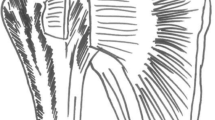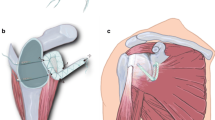Abstract
Purpose
Management of the subscapularis tendon during anatomic total shoulder arthroplasty (TSA) remains controversial. In our unit, subscapularis tenotomy is the preferred technique; however, the potential for tendon gapping and failure is recognised. The purpose of this study is to describe and provide early clinical results of a novel, laterally based V-shaped tenotomy (VT) technique hypothesised to provide greater initial repair strength and resistance to gapping than a transverse tenotomy (TT), with both clinically and radiologically satisfactory post-operative tendon healing and function.
Methods
A retrospective study of patients who underwent primary TSA with VT over a three year period was performed using shoulder and subscapularis-specific outcome scores, radiographs, and ultrasound. A separate cohort of patients who underwent TSA using a subscapularis sparing approach was also reviewed to provide comparative clinical outcomes of a group with TSA and an un-violated subscapularis.
Results
Eighteen patients were reviewed at mean 30.4 months (± 11.7). Constant (78.2 ± 12.3), UCLA (8.4 ± 1.5), pain VAS (2.3 ± 2.8), and strength in internal rotation were no different from the comparison group. Likewise, neither were the clinical outcomes of range-of-motion, belly-press, lift-off, and shirt-tuck tests. One patient (5.5%) was found to have a failed subscapularis repair on ultrasound.
Conclusion
VT during TSA appears to provide healing rates at least equal to those reported for TT, and not dissimilar from those of lesser tuberosity osteotomy. Clinical outcomes are comparable to reported results in the literature for alternative techniques, and not different from those observed here in a comparison cohort with TSA performed without violating the subscapularis tendon.
VT therefore potentially offers a more effective and secure tendon repair than a traditional TT, with at least comparable clinical outcomes.



Similar content being viewed by others
Data availability
N/A
References
Wirth MA, Loredo R, Garcia G, Rockwood CA Jr, Southworth C, Iannotti JP (2012) Total shoulder arthroplasty with an all-polyethylene pegged bone-ingrowth glenoid component: a clinical and radiographic outcome study. J Bone Joint Surg Am 94(3):260–267. https://doi.org/10.2106/JBJS.J.01400
Wright TW, Flurin PH, Crosby L, Struk AM, Zuckerman JD (2015) Total shoulder arthroplasty outcome for treatment of osteoarthritis: a multicenter study using a contemporary implant. Am J Orthop (Belle Mead NJ) 44(11):523–526
Deshmukh AV, Koris M, Zurakowski D, Thornhill TS (2005) Total shoulder arthroplasty: long-term survivorship, functional outcome, and quality of life. J Shoulder Elb Surg 14(5):471–479. https://doi.org/10.1016/j.jse.2005.02.009
Miller S, Hazrati Y, Klepss S, Chiang A, Flatow E (2003) Loss of subscapularis function after total shoulder replacement: a seldom recognized problem. J Shoulder Elb Surg 1:29–34. https://doi.org/10.1067/mse.2003.128195
Miller BS, Joseph TA, Noonan TJ, Horan MP, Hawkins RJ (2005) Rupture of the subscapularis tendon after shoulder arthroplasty: diagnosis, treatment, and outcome. J Shoulder Elb Surg 14(5):492–496. https://doi.org/10.1016/j.jse.2005.02.013
Budge MD, Nolan EM, Wiater JM (2011) Lesser tuberosity osteotomy versus subscapularis tenotomy: technique and rationale. Oper Tech Orthop 21:39–43. https://doi.org/10.1053/j.oto.2010.09.010
Moeckel B, Altchek D, Warren R, Wickiewicz T, Dines D (1993) Instability of the shoulder after arthroplasty. J Bone Joint Surg Am 75:492–497
Lapner P, Pollock JW, Zhang T, Ruggiero S, Momoli F, Sheikh A, Athwal GS (2020) A randomized controlled trial comparing subscapularis tenotomy with peel in anatomic shoulder arthroplasty. J Shoulder Elb Surg 29(2):225–234. https://doi.org/10.1016/j.jse.2019.09.028
Ameziane Y, Schneider KN, Gosheger G, Mischke A, Schorn D, Rickert C, Liem D (2020) Single-row vs. double-row refixation of the subscapularis tendon after primary anatomic shoulder arthroplasty. Archives of Orthopaedic & Trauma Surgery:28. https://doi.org/10.1007/s00402-020-03423-5
Virk MS, Aiyash SS, Frank RM, Mellano CS, Shewman EF, Wang VM, Romeo AA (2019) Biomechanical comparison of subscapularis peel and lesser tuberosity osteotomy for double-row subscapularis repair technique in a cadaveric arthroplasty model. J Orthop Surg 14(1):391. https://doi.org/10.1186/s13018-019-1372-x
Levine WN, Munoz J, Hsu S, Byram IR, Bigliani LU, Ahmad CS, Kongmalai P, Shillingford JN (2019) Subscapularis tenotomy versus lesser tuberosity osteotomy during total shoulder arthroplasty for primary osteoarthritis: a prospective, randomized controlled trial. J Shoulder Elb Surg 28(3):407–414. https://doi.org/10.1016/j.jse.2018.11.057
Buckley T, Miller R, Nicandri G, Lewis R, Voloshin I (2014) Analysis of subscapularis integrity and function after lesser tuberosity osteotomy versus subscapularis tenotomy in total shoulder arthroplasty using ultrasound and validated clinical outcomes. J Shoulder Elb Surg 23:1309–1317. https://doi.org/10.1016/j.jse.2013.12.009
Caplan J, Whitfield B, Neviaser R (2009) Subscapularis function after primary tendon to tendon repair in patients after replacement arthroplasty of the shoulder. J Shoulder Elb Surg 19:193–196. https://doi.org/10.1016/j.jse.2008.10.019
DeFranco M, Higgins L, Warner J (2010) Subscapularis management in open shoulder surgery. J Am Acad Orthop Surg 18:707–717. https://doi.org/10.5435/00124635-201012000-00001
Gerber C, Yian E, Pfirrmann C, Zumstein M, Werner C (2005) Subscapularis muscle function and structure after total shoulder replacement with lesser tuberosity osteotomy and repair. J Bone Joint Surg Am 87:1739–1745. https://doi.org/10.2106/JBJS.D.02788
Giuseffi SA, Wongtriratanachai P, Omae H, Cil A, Zobitz ME, An K-N, Sperling JW, Steinmann SP (2012) Biomechanical comparison of lesser tuberosity osteotomy versus subscapularis tenotomy in total shoulder arthroplasty. J Shoulder Elb Surg 21(8):1087–1095. https://doi.org/10.1016/j.jse.2011.07.008
Jackson J, Cil A, Smith J, Steinmann S (2010) Integrity and function of the subscapularis after total shoulder arthroplasty. J Shoulder Elb Surg 19:1085–1090. https://doi.org/10.1016/j.jse.2010.04.001
Jandhyala S, Unnitha A, Hughes S, Hong T (2011) Subscapularis tenotomy versus lesser tuberosity osteotomy during total shoulder replacement: a comparison of patient outcomes. J Shoulder Elb Surg 20:1102–1107. https://doi.org/10.1016/j.jse.2011.03.019
Krishnan S, Stewart D, Reineck J, Lin K, Buzzell J, Burkhead W (2009) Subscapularis repair after shoulder arthroplasty: biomechanical and clinical validation of a novel technique. J Shoulder Elb Surg 18:184–192. https://doi.org/10.1016/j.jse.2008.09.009
Lafosse L, Schnaser E, Haag M, Gobezie R (2009) Primary total shoulder arthroplasty performed entirely thru the rotator interval: technique and minimum two-year outcomes. J Shoulder Elb Surg 18:864–873. https://doi.org/10.1016/j.jse.2009.03.017
Lapner P, Sabri E, Rakhra K, Bell K, Athwal G (2012) Comparison of lesser tuberosity osteotomy to subscapularis peel in shoulder arthroplasty. J Bone Joint Surg Am 94:2239–2246. https://doi.org/10.2106/JBJS.K.01365
Lapner P, Sabri E, Rakhra K, Bell K, Athwal G (2013) Healing rates and subscapularis fatty infiltration after lesser tuberosity osteotomy versus subscapularis peel for exposure during shoulder arthroplasty. J Shoulder Elb Surg 22:396–402. https://doi.org/10.1016/j.jse.2012.05.031
Leung K-S, Chong WS, Chow DHK, Zhang P, Cheung W-H, Wong MWN, Qin L (2015) A comparative study on the biomechanical and histological properties of bone-to-bone, bone-to-tendon, and tendon-to-tendon healing: an Achilles tendon-calcaneus model in goats. Am J Sports Med 43(6):1413–1421. https://doi.org/10.1177/0363546515576904
Choate WS, Kwapisz A, Momaya AM, Hawkins RJ, Tokish JM (2018) Outcomes for subscapularis management techniques in shoulder arthroplasty: a systematic review. J Shoulder Elb Surg 27(2):363–370. https://doi.org/10.1016/j.jse.2017.08.003
Shields E, Ho A, Wiater JM (2017) Management of the subscapularis tendon during total shoulder arthroplasty. J Shoulder Elb Surg 26(4):723–731. https://doi.org/10.1016/j.jse.2016.11.006
Peltz TS, Haddad R, Scougall PJ, Nicklin S, Gianoutsos MP, Oliver R, Walsh WR (2015) Structural failure mechanisms of common flexor tendon repairs. Hand Surg 20(3):369–379. https://doi.org/10.1142/S0218810415400092
Barrie KA, Tomak SL, Cholewicki J, Wolfe SW (2000) The role of multiple strands and locking sutures on gap formation of flexor tendon repairs during cyclical loading. J Hand Surg [Am] 25(4):714–720
Constant CR, Murley AH (1987) A clinical method of functional assessment of the shoulder. Clin Orthop Relat Res 214:160–164
Amstutz H, Sew Hoy A, Clarke I (1981) UCLA anatomic total shoulder arthroplasty. Clin Orthop Relat Res 155:7–20
Barth JR, Burkhart SS, De Beer JF (2006) The bear-hug test: a new and sensitive test for diagnosing a subscapularis tear. Arthroscopy 22(10):1076–1084
Tokish JM, Decker MJ, Ellis HB, Torry MR, Hawkins RJ (2003) The belly-press test for the physical examination of the subscapularis muscle: electromyographic validation and comparison to the lift-off test. J Shoulder Elb Surg 12(5):427–430
Gerber C, Krushell R (1991) Isolated rupture of the tendon of the subscapularis muscle: clinical features in 16 cases. J Bone Joint Surg (Br) 73:389–394
Warren R, Coleman S, Dines J (2002) Instability after arthroplasty: the shoulder. J Arthroplasty 17(4 Suppl. 1):28–31. https://doi.org/10.1054/arth.2002.32543
Sacevich N, Athwal G, Lapner P (2015) Subscapularis management in total shoulder arthroplasty. J Hand Surg [Am] 40:1009–1011. https://doi.org/10.1016/j.jhsa.2015.01.032
Schrock JB, Kraeutler MJ, Crellin CT, McCarty EC, Bravman JT (2017) How should I fixate the subscapularis in total shoulder arthroplasty? A systematic review of pertinent subscapularis repair biomechanics. Should Elb 9(3):153–159. https://doi.org/10.1177/1758573217700833
Savoie FH 3rd, Charles R, Casselton J, O'Brien MJ, Hurt JA 3rd (2015) The subscapularis-sparing approach in humeral head replacement. J Shoulder Elb Surg 24(4):606–612. https://doi.org/10.1016/j.jse.2014.07.020
Qureshi S, Hsiao A, Klug R, Lee E, Braman J, Flatow E (2008) Subscapularis function after total shoulder replacement: results with lesser tuberosity osteotomy. J Shoulder Elb Surg 17:68–72. https://doi.org/10.1016/j.jse.2007.04.018
Schrock JB, Kraeutler MJ, Houck DA, Provenzano GG, McCarty EC, Bravman JT (2016) Lesser tuberosity osteotomy and subscapularis tenotomy repair techniques during total shoulder arthroplasty: a meta-analysis of cadaveric studies. Clin Biomech 40:33–36. https://doi.org/10.1016/j.clinbiomech.2016.10.013
Armstrong A, Lashgari C, Teefey S, Menendez J, Yamaguchi K, Galatz L (2006) Ultrasound evaluation and clinical correlation of subscapularis repair after total shoulder arthroplasty. J Shoulder Elb Surg 15:541–548. https://doi.org/10.1016/j.jse.2007.04.018
Ponce B, Ahluwalia R, Mazzocca A, Gobezie R, Warner J, Millett P (2005) Biomechanical and clinical evaluation of a novel lesser tuberosity repair technique in total shoulder arthroplasty. J Bone Joint Surg Am 87(Suppl 2):1–8. https://doi.org/10.2106/JBJS.E.00441
Van den Berghe G, Nguyen B, Patil S, D'Lima D, Mahar A, Pedowitz R, Hoenecke H (2008) A biomechanical evaluation of three surgical techniques for subscapularis repair. J Shoulder Elb Surg 17:156–161. https://doi.org/10.1016/j.jse.2007.04.016
Scalise J, Ciccone J, Iannotti J (2010) Clinical, radiographic, and ultrasonographic comparison of subscapularis tenotomy and lesser tuberosity osteotomy for total shoulder arthroplasty. J Bone Joint Surg Am 2010(92):1627–1634. https://doi.org/10.2106/JBJS.G.01461
Viinikainen AK, Goransson H, Huovinen K, Kellomaki M, Tormala P, Rokkanen P (2009) Bioabsorbable poly-L/D-lactide (PLDLA) 96/4 triple-stranded bound suture in the modified Kessler repair: an ex vivo static and cyclic tensile testing study in a porcine extensor tendon model. J Mater Sci Mater Med 20(9):1963–1969. https://doi.org/10.1007/s10856-009-3747-8
Trail IA, Powell ES, Noble J (1989) An evaluation of suture materials used in tendon surgery. Hand Surg Br 14(4):422–427
Thurman RT, Trumble TE, Hanel DP, Tencer AF, Kiser PK (1998) Two-, four-, and six-strand zone II flexor tendon repairs: an in situ biomechanical comparison using a cadaver model. J Hand Surg [Am] 23(2):261–265
Acknowledgements
This paper presents independent research supported by the National Institute for Health Research (NIHR) Leeds Biomedical Research Centre (BRC). The views expressed are those of the author(s) and not necessarily those of the NIHR or the Department of Health and Social Care.
Author information
Authors and Affiliations
Corresponding author
Ethics declarations
Conflict of interest
L.L. is a consultant for DePuy/Mitek, Stryker, and OrthoSpace.
I-A.P and J.E.P. have participated in a shoulder fellowship programme sponsored by DePuy/Mitek
Ethics approval
All procedures performed in studies involving human participants were in accordance with the ethical standards of the institutional and/or national research committee and with the 1964 Helsinki declaration and its later amendments or comparable ethical standards. This study was approved by the local IRB and registered with the IRB approval number CERC-S-2017-03.
Consent to participate
Freely given, informed consent was obtained from all patients in this study for all procedures undertaken and all data obtained.
Consent to publish
No patient identifiable data is included in this manuscript.
Code availability
N/A
Additional information
Publisher’s note
Springer Nature remains neutral with regard to jurisdictional claims in published maps and institutional affiliations.
All work carried out at: Alps Surgery Institute, Clinique Générale d’Annecy, 4 Chemin de la Tour la Reine, 74000, Annecy, France
Rights and permissions
About this article
Cite this article
Henderson, D.J.H., Christensen, T.J., Vo, A. et al. The V-shaped subscapularis tenotomy for anatomic total shoulder arthroplasty. International Orthopaedics (SICOT) 45, 199–208 (2021). https://doi.org/10.1007/s00264-020-04880-8
Received:
Accepted:
Published:
Issue Date:
DOI: https://doi.org/10.1007/s00264-020-04880-8




